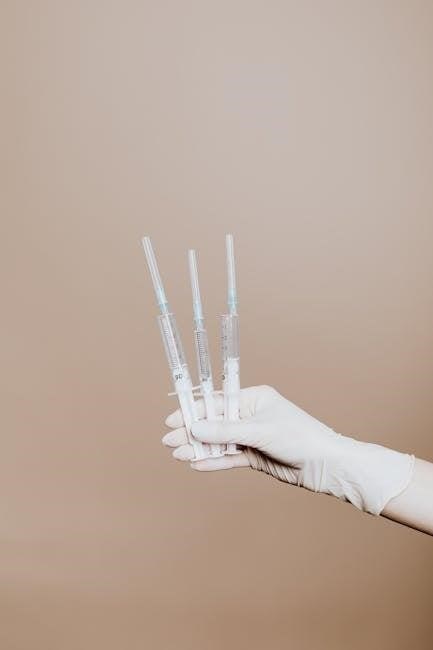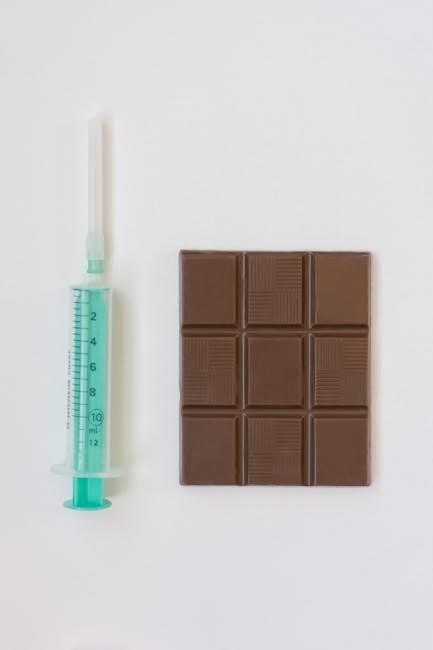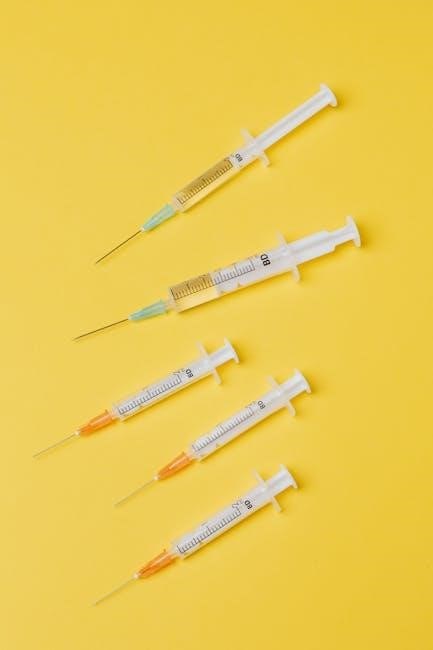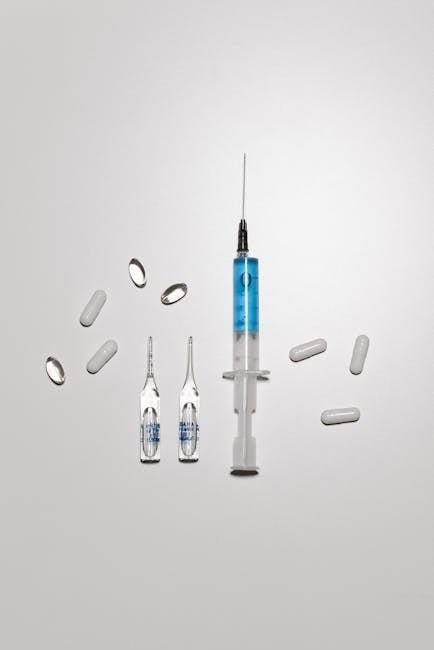Fluoroscopy-guided injection is a real-time X-ray imaging technique used to precisely guide needle placements and administer medications, enhancing treatment efficacy and accuracy in various medical procedures.
1.1 What is Fluoroscopy-Guided Injection?
Fluoroscopy-guided injection is a medical imaging technique that uses real-time X-ray visualization to precisely guide needle placements and administer medications. It allows healthcare providers to visualize the target area during procedures, ensuring accurate delivery of therapeutic agents. This method is widely used for joint injections, spinal procedures, and other interventions requiring high precision and real-time monitoring.
1.2 Historical Background and Development
Fluoroscopy-guided injection originated in the early 20th century with the discovery of X-rays by Wilhelm Roentgen. Initially used for diagnostic imaging, it evolved to guide injections, with advancements in technology improving precision and safety. The development of contrast agents and modern imaging systems has enhanced its effectiveness, making it a cornerstone in interventional medicine.

Applications of Fluoroscopy in Medical Procedures
Fluoroscopy is widely applied in joint injections, spinal procedures, and epidural injections, ensuring precise needle placement and medication delivery in real-time, enhancing diagnostic and therapeutic outcomes.
2.1 Joint and Musculoskeletal Injections
Fluoroscopy-guided injections are commonly used for joint and musculoskeletal procedures, enabling precise needle placement in shoulders, knees, and hips. This technique ensures accurate delivery of corticosteroids or hyaluronic acid, reducing inflammation and pain. Real-time imaging enhances accuracy, minimizes complications, and improves outcomes for patients with arthritis or degenerative joint conditions, making it a preferred method for musculoskeletal interventions.
2.2 Spinal and Epidural Injections
Fluoroscopy-guided spinal and epidural injections enable precise needle placement in the epidural space, facet joints, or nerve roots. This technique ensures accurate delivery of steroids or anesthetics, minimizing complications and enhancing pain relief for conditions like spinal stenosis or chronic back pain. Real-time imaging improves safety and efficacy, making it a preferred method for spinal interventions.
2.3 Other Medical Uses of Fluoroscopy
Fluoroscopy is also used in gastrointestinal procedures, such as swallowing studies, and for guiding catheter placements in vascular access. It aids in pain management by visualizing nerve blocks and tumor treatments. Additionally, fluoroscopy assists in orthopedic procedures, like fracture reductions, and is invaluable in guiding aspirations and biopsies, ensuring precise tissue sampling and minimizing complications.

Benefits of Fluoroscopy-Guided Injection
Fluoroscopy-guided injection offers enhanced precision, real-time visualization, and cost-effectiveness, making it a valuable tool in modern medicine for accurate and efficient procedures;
3.1 Enhanced Accuracy in Injection Placement
Fluoroscopy-guided injection provides real-time imaging, enabling precise needle placement and medication delivery. This reduces errors and improves therapeutic outcomes, making it a reliable method for accurate procedures.
3.2 Real-Time Visualization and Monitoring
Fluoroscopy provides continuous, real-time X-ray imaging, allowing healthcare providers to monitor procedures dynamically. This capability ensures accurate guidance during injections, enabling precise placement of needles and medications. The real-time feedback enhances safety and effectiveness, particularly in complex anatomical structures, making it invaluable for minimizing complications and improving patient outcomes.
3.3 Cost-Effectiveness and Availability
Fluoroscopy-guided injection is widely regarded for its cost-effectiveness and accessibility. It is readily available in most medical facilities, offering a low-cost alternative to other imaging techniques like MRI or CT; Its simplicity and efficiency make it a preferred choice for many procedures, ensuring affordable and high-quality care for patients while maintaining clinical efficacy.

Procedure and Technique
Fluoroscopy-guided injection involves real-time X-ray imaging to guide needle placement, ensuring precise delivery of medication. The procedure is minimally invasive, utilizing continuous imaging for accurate targeting.
4.1 Patient Preparation and Positioning
Patient preparation involves informing them about the procedure, removing jewelry or metal items, and positioning them on an X-ray table. The area is cleaned, and local anesthesia may be administered. The patient is positioned to optimize fluoroscopic visualization, ensuring the target area is accessible. Proper alignment is crucial for accurate needle placement and procedure success.
4.2 Equipment and Setup Requirements
Fluoroscopy-guided injection requires a fluoroscopy machine with a high-resolution monitor, a sterile injection kit, and appropriate contrast agents. Protective gear like lead aprons and gloves is essential for radiation safety. The setup involves calibrating the machine, ensuring proper patient positioning, and sterilizing the injection site. Adequate lighting and a stable power supply are crucial for uninterrupted procedure execution. Regular equipment maintenance ensures optimal performance and safety.
4.3 Step-by-Step Injection Technique
The procedure begins with skin disinfection and local anesthesia administration. Under fluoroscopic guidance, the needle is advanced to the target site. Contrast agents may be injected to confirm placement. The medication is then slowly administered while monitoring the flow. Continuous fluoroscopic imaging ensures precise delivery, minimizing risks and improving outcomes. Post-injection, the site is bandaged, and the patient is observed for reactions. Proper technique ensures safety and efficacy, supported by real-time imaging. Regular training and adherence to protocols are essential for optimal results.

Risks and Complications
Fluoroscopy-guided injection carries risks, including radiation exposure, infection, bleeding, or nerve damage. Proper technique minimizes complications, ensuring patient safety and procedural efficacy.
5.1 Radiation Exposure and Safety Concerns
Fluoroscopy-guided injection involves X-ray radiation, posing risks of exposure to both patients and operators. Proper shielding, dose monitoring, and adherence to safety protocols minimize these risks. The benefits of precise guidance often outweigh the radiation concerns, but careful technique is essential to ensure safety and efficacy in medical procedures.
5.2 Potential Complications and Side Effects

Fluoroscopy-guided injections may lead to complications such as bleeding, infection, or nerve damage at the injection site. Allergic reactions to contrast agents or medications are also possible. While rare, these risks highlight the importance of proper technique and patient monitoring to ensure safe and effective outcomes.

Comparison with Other Imaging-Guided Techniques
Fluoroscopy-guided injections are compared to ultrasound, CT, and MRI-guided methods, balancing real-time imaging, cost, and radiation exposure, with each technique offering unique advantages for specific clinical scenarios.
6.1 Ultrasound-Guided vs. Fluoroscopy-Guided Injections
Both fluoroscopy-guided and ultrasound-guided injections are effective, but they offer distinct advantages. Fluoroscopy provides real-time X-ray imaging, making it ideal for complex injections requiring precise needle placement. Ultrasound, on the other hand, is non-invasive, avoids radiation, and is cost-effective. The choice between the two often depends on the clinical scenario, availability of equipment, and the practitioner’s expertise.
6.2 MRI and CT-Guided Injections
MRI and CT-guided injections provide high-resolution imaging for precise needle placement, especially in complex anatomical regions. MRI offers superior soft tissue detail without radiation, while CT scans provide excellent spatial resolution. Both are valuable alternatives to fluoroscopy, though they are generally more expensive and less accessible. They are often reserved for cases where fluoroscopy is insufficient.

Patient Preparation and Aftercare
Patient preparation includes fasting and avoiding certain medications. Post-procedure care involves monitoring for complications and following specific recovery instructions to ensure safety and optimal outcomes.
7.1 Pre-Procedure Instructions
Patients are advised to fast for several hours before the procedure and avoid certain medications, especially blood thinners. They should inform their doctor about allergies, medical conditions, or pregnancy. Proper preparation ensures safety and optimal results during the fluoroscopy-guided injection, minimizing risks and complications.
7.2 Post-Procedure Care and Recovery
After the procedure, patients should rest and avoid strenuous activities for 24-48 hours. Monitoring for complications like swelling or pain is essential. Patients may resume normal activities gradually, with pain relief managed as directed. Follow-up appointments are recommended to assess treatment efficacy and address any concerns, ensuring proper recovery and minimizing potential side effects.
Future Advances in Fluoroscopy Technology
Advancements include reduced radiation exposure, enhanced real-time imaging, and integration with AI for improved accuracy, promising safer and more efficient fluoroscopy-guided injection procedures in the future.
8;1 Emerging Trends in Imaging Technology
Emerging trends include the integration of AI for enhanced image analysis, high-resolution imaging systems, and low-dose radiation technologies. These advancements aim to improve accuracy, reduce radiation exposure, and enable real-time monitoring during fluoroscopy-guided injections, making procedures safer and more efficient for both patients and healthcare providers.
8.2 Enhancing Safety and Efficacy
Advancements in fluoroscopy technology focus on balancing imaging needs with radiation exposure. Improved shielding, dose-reduction algorithms, and real-time monitoring systems enhance patient and operator safety. Additionally, operator training and standardized protocols further elevate the efficacy of fluoroscopy-guided injections, ensuring precise and safe outcomes while minimizing potential risks associated with the procedure.

Cost and Accessibility Considerations
Fluoroscopy-guided injections are cost-effective due to their widespread availability and lower equipment costs compared to advanced imaging modalities, making them accessible for many healthcare systems and patients.
9.1 Economic Impact on Healthcare Systems
Fluoroscopy-guided injections are cost-effective, reducing financial burdens on healthcare systems. Their lower equipment and operational costs compared to MRI or CT scans make them accessible, enabling widespread use and improving patient access without significant budget increases.
9.2 Insurance Coverage and Patient Costs
Insurance typically covers fluoroscopy-guided injections, reducing patient costs. However, out-of-pocket expenses vary depending on insurance plans, deductibles, and geographic location. Prior authorization may sometimes be required, potentially increasing administrative burdens. Despite this, the procedure remains cost-effective for patients compared to alternative imaging-guided methods.
Fluoroscopy-guided injections remain a cornerstone in modern medicine, offering precision and versatility across various procedures. Their effectiveness, coupled with advancing technology, ensures continued relevance in future healthcare practices.
10;1 Summary of Key Points
Fluoroscopy-guided injections offer enhanced accuracy and real-time visualization, making them invaluable in joint, spinal, and musculoskeletal procedures. Their cost-effectiveness and wide availability contribute to their popularity. The technique balances efficacy with safety concerns, such as radiation exposure, ensuring precise medication delivery. Ongoing advancements aim to improve safety and efficiency, solidifying their role in modern medical practice.
10.2 Future Outlook for Fluoroscopy-Guided Injections
Fluoroscopy-guided injections are expected to evolve with advancements in imaging technology, focusing on reducing radiation exposure and enhancing precision. Integration with artificial intelligence and real-time tracking systems could further improve outcomes. Expanded applications in minimally invasive procedures and personalized medicine will likely increase their demand, ensuring their continued relevance in modern healthcare.



0 Comments